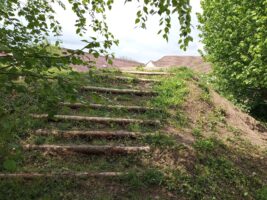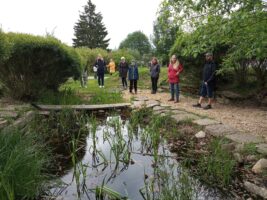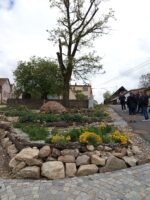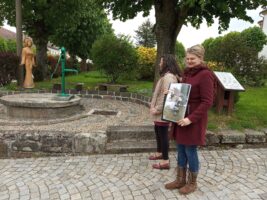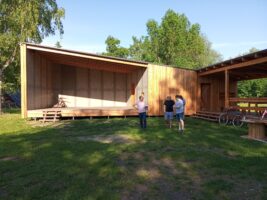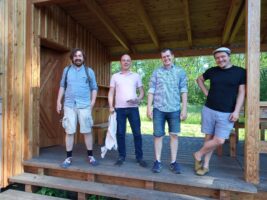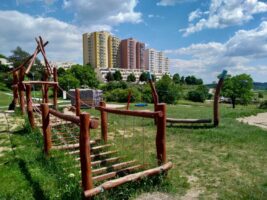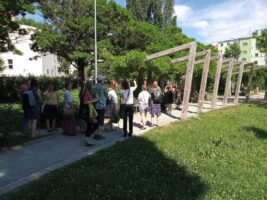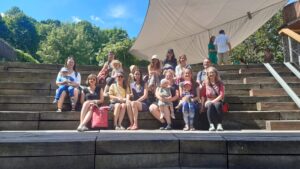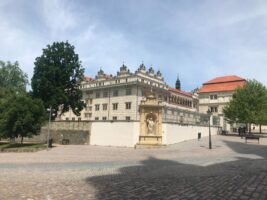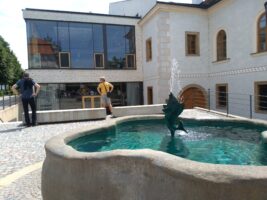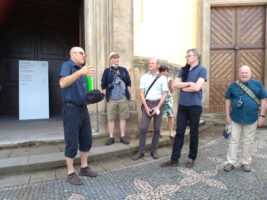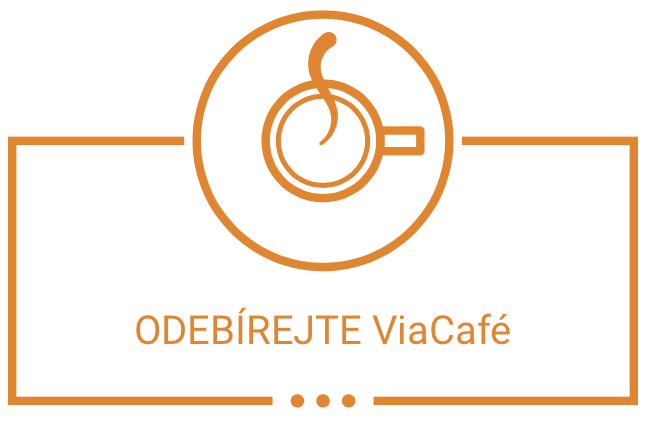In our program The Community in Which We Live, we help people revitalize a public space in their town. One of the first steps is typically a community meeting, where residents brainstorm about how they want to use the space and what type of place they want it to be. Before plunging into that process, residents can benefit from seeing other public spaces to spark their creativity and also learn about practical challenges of public space revitalization. To that end, we took four groups from our current The Community in Which We Live program to see inspiring public spaces in other towns — Strmilov, Plavsko, Velvary, Brno and Litomyšl. Our trip participants saw very recently revitalized public spaces as well as parks that had been developed some years prior, where they could see how the spaces had evolved. They returned home bursting with inspiring ideas!
Our first trip took us to Plavsko in South Bohemia, where we toured a preschool garden that had been planned by parents and children of the preschool as well as other residents. Our trip participants included a group from Moravské Budějovice, who are planning to transform a space on the Heřmansky Hill natural area, and a group from Votice, who are revitalizing a cloister garden. The preschool garden in Plavsko was created some ten years ago, so our participants were able to see how it had held up after so many years of intensive use by young children. It was clear that the original site design, which features a small pond and grassy mounds for children to play on, was still serving as the backbone of the space. Minor wooden elements and plantings had needed replacement.
Strmilov continues to transform its public spaces
From Plavsko we headed to Strmilov, where we were eager to see the U Koule park, which had been created through our The Community in Which We Live program some years ago. Before we visited it, however, the deputy mayor and librarian took us to see several other public spaces that residents had renovated more recently. We learned that the success of the U Koule park project had inspired locals to install wooden statues and plantings at intersections and renovate a well with a pump. These improvements also serve to help rainwater penetrate the soil.
At the U Koule park, we saw that the town had been steadily continuing to improve the site in the years since the original project. Some features of the original design which had been over-budget then – namely a large covered areas for events – had been completed.
Malvaňák in Velvary
We’ve taken plenty of fledging public space revitalization teams to see Malovarsky Lake in Velvary – and after talking with project leader Radim Wolak and seeing what residents were able to achieve, they inevitably go home convinced that participatory planning is well worth the effort. This time was no different! Our trip participants were the group from Prague-Holešoviče, who are planning to revitalize a park around the Hercovka villa through our current The Community in Which We Live program. We met with Radim, who shared the story of how residents revitalized this historical swimming area, which was the gem of the town during the First Czechoslovak Republic. He talked with us in a small wooden building on the site, which was a fitting choice of location – for it was the brainchild of residents during the park planning process. And a very good idea it was, indeed. It is now a service building for community events, where snacks are sold, concerts are held and clubs meet. Radim also told us about his own journey from leading a local community association to leading the town as its mayor, which added another dimension of inspiration to the day.
Visiting parks in Brno with the Kunštát group
Another of our current projects is taking place in Kunštát, where the local group is renovating a forest site called Jelínkova chata. We took them to see three inspiring parks in nearby Brno that had been developed through the collaborative efforts of citizens, elected officials, civil servants and designers. Today, all three sites are popular with Brno residents. Our first stop was a park in the inner courtyard of buildings on the streets Poříčí and Křídlovická, where we were guided by architect Eva Wagnerová. This park, which was created through a participatory project initiated by the then-deputy mayor, contains community gardens, a playground, edible plants, a dog park, and a barbeque and picnic area. Next we ventured to the Open Garden beneath the Špilberk Hill, led by landscape architect Hana Zuchnická. The Open Garden is part of Nadace Partnerství’s environmentally-friendly headquarters and is adjacent to a passive ecological administrative building on the same site. It is used by school groups and the public. Finally, we visited the Pod Plachtami park in the Brno district of Nový Lískovec, accompanied by architect Petr Förchtgott and Michal Šípek of the local town hall. This park, which boasts meadows and a pond fed by rainwater collected from high rise apartment buildings, was created through a participatory planning process with local residents.
Continuity in public space design in Litomyš
Litomyšl is known for elegantly blending the town’s historical character with modern design elements. A stroll through the town brings this reputation to life. We took a broad group from Vodňany, who are revitalizing an open space next to their town library through our current The Community in Which We Live program, to see Litomyšl. They were struck by the emphasis on continuity expressed by both the mayor and the deputy mayor in separate meetings – it seems that this is a key theme in the town’s approach to public space. Indeed, Litomyšl has managed to maintain a clear direction since the 1990s, even though 5 mayors from different political and local groups have taken a turn in office. All 5 of these mayors meet once a month to talk over lunch.
One of the ways that Litomyšl is inspiring is its approach to supermarkets, which are so often unsightly additions to historical towns. Here, however, the one supermarket that is close to downtown is appropriately set in the surrounding context and its facade is free of loud advertising. The company which built this supermarket also managed the remodelling of the town’s bus station, which is nearby, and the two buildings share a uniform design style. According to the mayor, the town’s goal is to improve residents’ quality of life – not maximize profits through sales of municipal property. They sell properties according to the estimated price, but only to developers who submit a high quality design concept that meets the needs of the town in terms of building use and design.
In addition, since 2020 the town has been using a participatory budget, which gives residents a chance to vote on the projects they would like the town to fund. Last year, for instance, residents opted to purchase a defibrilator for the town hospital, renovate a valley natural site, and revitalize a sports field and an orchard. This year, CZK 700,000 has been allocated for the participatory budget.

